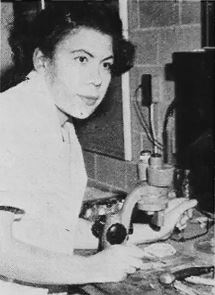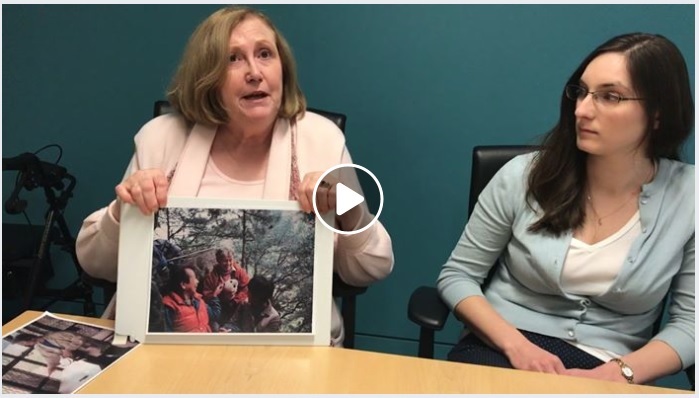In celebration of Women's History Month 2018, the Smithsonian Transcription Center invites you to transcribe collections highlighting the historical contributions of women in science, technology, and art to make these collections more accessible!
Spread the Word!
Use our designated hashtag, #DiscoverTCwomen, to spread the word about all your hard work. And feel free to call on other #volunpeers to help you out. It takes a village!
Annie Jump Cannon (1863-1941) was a deaf astronomer who classified about 350,000 stars, a task foundational to our understanding of stellar evolution. With this vast collection of knowledge, Cannon created a system for categorizing and understanding the stars which is still in use today with only minor updates. Recognizing the difficulty that women faced in entering a scientific profession, Annie Jump Cannon created a prize for women “whose contributions to the science of astronomy are the most distinguished,” which is still awarded today by the American Astronomical Society.
See Related Resources: Project PHaEDRA and Related Transcription Projects: Annie Jump Cannon Notebooks
Esther McCoy (1904-1989) is remembered for work as an architectural historian, critic, and proponent of Southern California modern architecture of the early to mid-twentieth century. Although her professional interests ranged from writing fiction to studying the folk architecture and crafts of Mexico, McCoy achieved her most notable success for her numerous articles, books, and exhibitions about Southern California architecture and the architects associated with the modernist movement. McCoy’s 1926 diary documents her first year in New York City after she left the University of Michigan to begin her writing career. This, other diaries, and extensive material which documents her life and career are fully digitized and available through the Esther McCoy Papers on the Archives of American Art website.
See Related Resources: Esther McCoy Papers, 1876-1990, bulk, 1938-1989 and Related Transcription Project: McCoy’s 1926 diary documents her first year in New York City after she left the University of Michigan to begin her writing career.
Zoologist Dr. Devra Kleiman came to the Smithsonian’s National Zoological Park in 1972, where she quickly began to focus on species on the verge of extinction. In what has been called "one of the greatest success stories in the history of modern zoos," Kleiman worked to bring the golden lion tamarin population back in Brazil. Her work with giant pandas led to four pregnancies by the Zoo’s panda Ling-Ling, and later to the birth of the Zoo’s first ever panda cub to survive in captivity. The legacy of Dr. Kleiman’s work in conservation biology endures as man-made threats to animals are as present today as they were in 1970s.
See Related Resources: Devra G. Kleiman Papers, 1967-2010, Smithsonian Institution Archives, Accession 11-124., The Archival Legacy of Devra Kleiman, The Bigger Picture, and Related Transcription Project Brazil field notes, May - June 1984, Brazil Field Notes, May - July 1985 , Brazil Field Notes, February 1986
Elayne Zorn (1952-2010) was an anthropologist, weaver and musician who specialized in the study of textiles, of tourism and of cultural change in the Andes. In the 1970s she began a long association with the community on the Island of Taquile, in the Puno region of Peru, conducting fieldwork on native weaving techniques. Zorn worked as Professor of Anthropology at the University of Central Florida from 1998 until 2010. In addition to her academic duties, throughout her career Zorn collaborated with various museums and cultural institutions as a consultant and collector. Zorn’s collection of field notes and photographs documents her extensive work in Peru and Bolivia throughout her career and accompanied a large collection of textiles and musical instruments donated to the National Museum of the American Indian.
See Related Resources: Elayne Zorn Collection, Related Transcription Project Elayne Zorn Collection – Taquile Field Notes, 1975-1977

Henrietta Swan Leavitt (1868-1921) was a deaf astronomer who discovered over 2,400 variable stars, many of which lie within the two dwarf galaxies known as the Magellanic Clouds. Her intense study of these objects led her to understand that there was a very specific relationship between the period and luminosity of a particular kind of variable star called a Cepheid. This relationship, called the Leavitt Law, allows us to measure distances in space. Leavitt also developed the logarithmic scale used to measure stellar magnitudes, still in use today.
See Related Resources: Project PHaEDRA and Related Transcription Projects: Henrietta Swan Leavitt Notebooks
Sculptor and art patron Gertrude Vanderbilt Whitney was the eldest daughter of Cornelius Vanderbilt II and Alice Gwynne Vanderbilt. She opened the Whitney Studio Club in 1918, which in 1928 transformed into an art gallery, known as the Whitney Studio Galleries and directed by Juliana Force. The gallery eventually became the Whitney Museum of American Art in 1931. Whitney began keeping journals as a child, and was a prolific diarist throughout her life.
See Related Resources: Gertrude Vanderbilt Whitney Papers, 1851-1975, bulk 1888-1942 and Related Transcription Projects: Vanderbilt’s Journal, Vol. I documents a trip to Paris and her life from May through September of 1890, and Vanderbilt’s Journal, Vol. II, documents her personal impressions and activities from September through December of 1890.

Margaret Collins’ interest in termites was sparked by her chance reading of a children’s book on the insect that she happened upon while studying at the University of Chicago. Her fascination with the specimen led Collins to become the first African American, female entomologist, teaching at three universities, and performing research at many institutions. In addition to being a pioneer in her field, Collins was a civil rights leader among her fellow black scientists. “A lot of people opposed our civil rights efforts. I had to do what I thought was the most important thing. That’s all there was to it.”
See Related Resources: Field Notes From a Termite Lady, Smithsonian Field Book Project Blog, November 6, 2012 Warren, Wini. 1999. Black women scientists in the united states. Bloomington: Indiana University Press. Related Transcription Project Peru and Guyana, notes, 1985

Cecilia Payne-Gaposchkin (1900-1979) was the first person to figure out that stars are made predominantly of hydrogen which was an outlandish theory during her time. Based on this discovery, she was the first to theorize that hydrogen was the most abundant element in the universe. Payne-Gaposchkin was the first person to earn a PhD in Astronomy from Harvard and the first woman to chair a department at Harvard. After retiring from teaching in 1966, Payne-Gaposchkin continued her astronomical research as a staff member of the Smithsonian Astrophysical Observatory.
See Related Resources:Project PHaEDRA and Related Transcription Projects: Cecilia Payne-Gposchkin Notebooks
Explore Transcription Projects
- Smithsonian Institution Archives – Margaret Collins (b. 1922–d. 1996): First African-American, female entomologist in the U.S. and Civil Rights advocate who worked at the Smithsonian’s National Museum of Natural History
- Smithsonian Institution Archives– Devra Kleiman (b. 1942–d. 2010): First female scientist at the Smithsonian’s National Zoo, conservation biologist who developed protocol to breed and reintroduce endangered golden lion tamarin into the wild.
- Harvard-Smithsonian Center for Astrophysics – Project PHaEDRA At Harvard College Observatory (now the Harvard-Smithsonian Center for Astrophysics), women computers studied glass plate photographs of the night sky, cataloging stars, identifying variables, interpreting stellar spectra, counting galaxies, and measuring the vast distances in space. Several of them made game-changing discoveries in astronomy and astrophysics. Follow the work of Annie Jump Cannon, who devised an elegant stellar classification scheme, Cecilia Payne-Gaposchkin, who discovered that stars were made abundantly of hydrogen, and Henrietta Swan Leavitt, who helped us understand the vastness of our universe.
- Archives of American Art - Women Artists and Historians The vast holdings at the Archives of American Art consist of resources critical to the study of American art, artists, and culture. The lives and careers of women in the art world, including artists, dealers, collectors, critics, scholars, and other art world figures, are documented through letters, diaries, scrapbooks, manuscripts, financial records, photographs, films, and audiovisual recordings. Celebrate Women’s History Month by exploring and transcribing two diaries from groundbreaking women in the art world- Gertrude Vanderbilt Whitney, a sculptor and art patron, and Esther McCoy, a notable architectural historian and critic.
Also watch our video on Smithsonian women scientists below:

